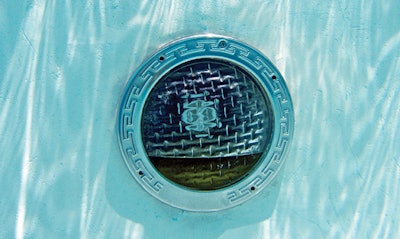
It’s no secret that hotels and other commercial entities use swimming pools as a promotional tool. With so many bodies in these high profile installations, it should be safe to assume that these pools are relatively hazard-free, right? Not so, says builder/designer Mark Holden, who has personally inspected scores of pools with sobering results.
Warning: What follows here is most assuredly going to be a bitter pill for many people in the pool industry. Here’s why.
For nearly a decade, I’ve conducted countless safety inspections of mostly public swimming pools and spas, as well as some residential. The majority of these were hotels, hotel chains and resort properties that wanted to know in specific terms how safe their pools were and what they needed to do in order to ensure bather safety.
The problems I have seen run the gamut, including poor hydraulics, non-code-compliant and lethal electrical systems, improper deck construction and bad water quality. Often I’ve seen disturbing combinations of these problems.
Overall, the conditions we encountered were far, far worse than most people in our industry would dare to imagine or admit. So much so that I’ve been prompted to ask myself a fundamental question: Knowing what I know now, would I let my own children swim in these often badly neglected vessels? The answer is quite simply a resounding “No!” The following summarizes the reasons for that sweeping caveat. Keep in mind that in most cases, although these were commercial pools, everything we found is of equal importance on the residential side of the market.
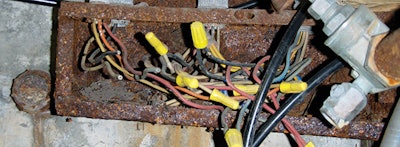
It’s also worth noting that many of the pools mentioned here were poorly maintained by people who obviously have no qualifications. In other cases, however, the trouble was due to mistakes in the original construction, improper remodels or shoddy repairs. In the end, public pools are supposed to be stringently monitored by county health officials, but quite often their perspective becomes clouded — just like the water they are in charge of.
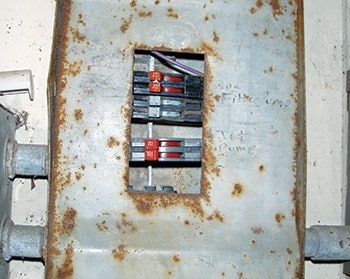

MANDATED CARE
Before I get into the more problematic scenarios, let’s first look at an area where we’ve seen significant improvement.
In the years following passage of VGB, the frequency of pool inspections increased as managers sought to come into compliance with the new law. We discovered scores of problems, including simple things like missing screws on drain covers as well as covers that were non-compliant, cracked or missing entirely. We also saw major issues such as single-suction drains, or split drains that were much too close to each other. And we saw issues with improperly plumbed skimmer equalizer lines.
In most cases, the property owners and managers had never even considered these issues prior to VGB, but after our inspections and recommendations, most of the properties we visited did come into compliance with the law.
Although the recommendations that have come out of VGB could still be open to question and some debate, the overall bottom line is that VGB did, in fact, prompt huge numbers of commercial facilities to upgrade their hydraulic systems, at least where suction entrapment risks are concerned.
What’s interesting about VGB in the context of this discussion is how it addresses a problem that is so remarkably rare. No question, even one suction entrapment incident is unacceptable, and the fact that there have been none since passage of the bill (at least none that have been widely reported) is a great thing. But there are injury hazards that are far more common, such as those due to slip and fall incidents.
TRIPPED UP
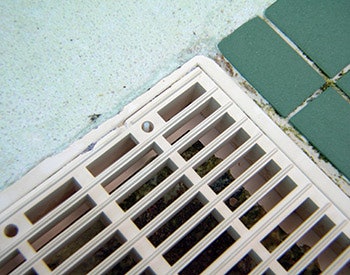

If you check out statistics on pool-related injuries, slip and fall incidents are far and away the most common. According to the Center for Disease Control, in 2005, 15,800 people age 65 and older died from fall-related injuries, 1.8 million age 65 and older were treated in emergency rooms for fall-related injuries, and more than 433,000 of these people were hospitalized.
Naturally, pool environments are ripe for these incidents when the deck isn’t built with proper drainage or finished with a slippery surface. The number of installations we’ve seen in which decks don’t drain properly, meaning water is allowed to puddle, has been staggering, even in commercial settings where the health departments are involved.
(In residential settings, it’s even worse. Because there’s no regulatory agency that monitors slip and fall hazards for pool environments, builders are free to use any material they want for decks and coping, meaning specifically ceramic or glass tile, the most slippery masonry material available.)
There’s no shortcut around this issue. Decks that don’t drain properly should be remodeled so the surfaces are pitched toward functioning drains. And the deck should be surfaced with non-slip material that’s approved by the health department.
Water on decks not only can result in slip and fall hazards, we’ve also seen one unusual situation where it resulted in an electrical shock hazard.
We were brought into a pool project we designed in which bathers were complaining of being shocked when they climbed out of the pool. It was happening in one spot, but only during the day during peak use hours. The problem seemed to vanish late at night or in the early morning. At first it was a real mystery. That is, until we noticed that the water from splash out was flowing across the deck to a nearby light pole.
The light was outside the 5-foot halo for bonding required by the NEC and was therefore not required to be bonded to the pool structure. That didn’t stop it from energizing the water that was flowing over the deck, resulting in bathers getting shocked when the deck was wet from people exiting the pool that naturally occurs when bathers climb out.
Fortunately, the fix was simply to run a bonding wire to the light pole, which solved the problem.
ELECTRICAL MESS
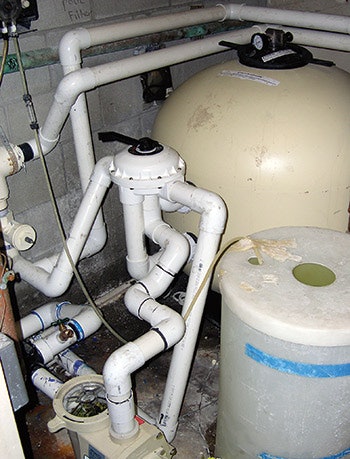
In that scenario, the pool system was in compliance with the NEC. Unfortunately, that’s often not the case.
One of the most common electrical problems we’ve seen involves light fixtures filling with water. In fact, we recently calculated that 35 percent of all public pool installations we’ve seen have this potentially nasty problem in common. As best we can tell, the problem occurs when lights are replaced and not properly resealed. Again, the fix is pretty simple: properly seal the light fixtures.
As serious as that problem could be, the NEC violations we’ve seen go far beyond that.
As an example, we inspected the pool at a major hotel in the heart of Los Angeles we determined was the most dangerous we’d ever seen.
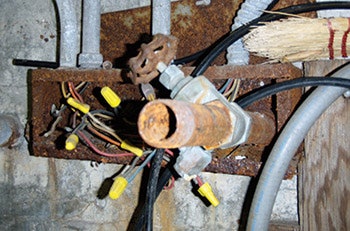
For starters, the equipment and plumbing leaked so badly that there was always an inch of standing water in the equipment room. The electrical system had been reworked and jerry-rigged so many times, none of the junction boxes had covers and there were all sorts of wires hanging out. The old, rusty circuit breaker panel had holes so large you could reach into it and touch exposed wiring. There were no GFCIs. In fact, that junction box had a hose bib cored through it with an operable bib next exposed high voltage wires — an unthinkably dangerous combination.
It was no surprise when we received an electrical shock as we inspected the space. Much to our chagrin, the managers of the facility did not take our recommendations seriously enough to do anything to correct the situation. Eventually we were forced to turn them in to their parent company and the county health authorities due to management’s apathy to this lethal situation. Unfortunately, although extreme, this incident is far from isolated. The general state of electrical systems running the pools we’ve inspected is entirely unacceptable.
WATER QUALITY
Any discussion pool safety must include pools with inadequate filtration and chemical treatment, and water that is cloudy, full of algae and redolent with that familiar chlorine smell, which we should all know by now is caused by chloramines.
The problem is especially pronounced in indoor pools where inadequate air handling exacerbates the situation, but make no mistake, it’s also an issue for outdoor vessels, as well. One such major hotel in the San Francisco area had such high levels of chloramines that swimmers in the natatorium room could only stand about 15 minutes of exposure until they fled the room for fresh air.In these situations we’ve made an array of recommendations including increasing the size of the filter and/or replacing old units with modern technology, updating the chemical feed system and educating staff about the proper use of test kits and overall water-quality management. Adequate ventilation doesn’t hurt either when swimmers cannot breathe while swimming.
In almost all of these situations, pointing out these problems is only part of the equation. Convincing managers to invest in upgrading their systems is another matter entirely.
For our part, conducting these inspections has become a fairly lucrative sideline and in a sense, pool professionals could reasonably view this deplorable state of affairs as an opportunity. I personally believe that our industry has an obligation to at least attempt to force the issue with managers and pool operators.
At it stands, based on our experience, it’s obvious both our industry and the hospitality industry have a very long way to go until I feel comfortable letting my kids swim in their pools. Call me paranoid but I never want my children to be a statistic, especially while recreating for leisure. Family fun should be, first and foremost, safe!
Comments or thoughts on this article? Please e-mail [email protected].











































